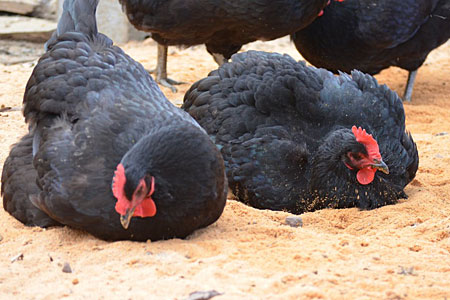
The stuff scattered over the floor of a chicken coop is often called bedding, because at night livestock bed down on. Although chickens may rest on the floor during the day, at night they would rather roost than bed. Therefore many people prefer to call it litter. Whatever you choose to call it, the best bedding for chickens offers numerous advantages: it absorbs moisture and manure, it cushions the birds’ feet, and it controls temperature by insulating the ground.
Properties of Good Bedding
Everyone has a favorite type of litter for use in the chicken coop. Sometimes the choice depends on price or what’s available locally. Regardless, the best bedding for chickens has these properties:
- Is inexpensive
- Is durable
- Is lightweight
- Is absorbent
- Readily releases moisture
- Isn’t dusty
- Is easy to handle
- Doesn’t pack readily
- Has medium-size particles
- Is low in thermal conductivity
- Is free of mustiness and mold
- Contains no toxic chemicals
- Makes good compost and fertilizer
Traditional Bedding
Wood shavings, especially pine, are the all-time favorite because they’re available nearly everywhere and are easy to manage. They’re both highly absorbent and readily release moisture. However, for gardening chicken keepers, pine shavings take a long time to compost. Poplar shavings, where available, compost faster, but are dustier. Sawdust of any kind is not the same as shavings, and because of the dust factor, is not good chicken litter.
Chopped straw is a traditional livestock bedding and a common alternative to wood shavings. It consists of mostly hollow stems left over from grain harvest. Wheat straw is best, followed by rye, oat, and buckwheat, in that order. Chopped straw makes nice loose, fluffy bedding that’s relatively free of dust. On the other hand, it doesn’t easily release moisture, leading to mold and ammonia fumes.
Straw that’s not chopped, however, mats into a pancake when combined with moist droppings and trampled by the chickens, creating an impenetrable mass that’s difficult to clean out. And it takes a long time to compost.
Hay looks a lot like straw, but consists of the whole plant, typically grass, that’s harvested as livestock feed. It is considerably more expensive than straw. It’s comparable to non-chopped straw in that it compresses into a solid layer of bedding that’s extremely difficult to clean out, so all around it’s not a good choice.
Bedding Alternatives
A good alternative to chopped straw is dry clippings from a lawn or pasture that’s not sprayed with toxins. The operative phrases here are “dry” and “not sprayed.”
Dried leaves are sometimes plentiful but pack too readily to make good bedding. Rice hulls and peanut hulls are cheap in some areas but are not absorbent enough to make good litter. Plus they tend to easily get moldy.
Shredded paper is at least as good as rice or peanut hulls and is inexpensive. Although it’s absorbent, it tends to retain moisture and to mat, but is workable with frequent replacement. In some areas you can buy shredded paper by the bale. Or you can make your own, given lots of newsprint and a paper shredder. Coated (shiny) paper is not absorbent enough for this purpose.
Construction sand makes terrific coop litter. It’s not the same thing as play sand, which is not good as chicken litter. Construction sand, however, has many excellent properties. It’s not dusty, is easy to clean, and releases moisture readily. Since it’s not an organic material, it doesn’t get moldy or attract pathogens. Although construction sand is initially expensive, it doesn’t need replacement as often as other litter options. But if you’re a gardener, you lose the fertilizer benefit of composting used coop litter.
Best Bedding
As you can see, there is no such thing as the best bedding for chickens. What’s “best” depends on what’s available at a price you can afford. Regardless of what you choose, keeping the litter dry and mold-free is a function of how often you replace it, or at least how often you remove accumulated poop and moist patches. With careful litter management, most of the available options work just fine.
And that’s today’s news from the Cackle Coop.
Gail Damerow has written numerous poultry-keeping books, many of them available from the Cackle Bookstore.

